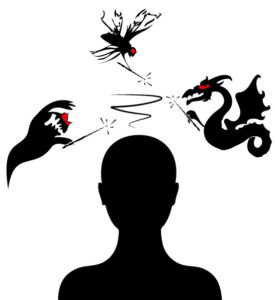What Are Thinking Traps?
Thinking traps, also known as cognitive distortions, are the negative-thinking patterns that take over our brain when we are stressed or anxious. (These were first outlined by Aaron Beck (1976) Cognitive Therapies and Emotional Disorders and furthermore by David Burns, the author of Feeling Good: The New Mood Therapy (1980).) Although these thinking traps are based on irrational thoughts, we convince ourselves that our thoughts are absolutely true. Today I’ll summarize some of them and in my next article I will describe the remaining ones. You may notice that as your children return to school, and their anxiety may be on the rise, that some of these thinking traps are taking hold of their thoughts.
Black and White Thinking
This is also known as “all or nothing thinking”. Black and white thinking happens when one believes that unless something is entirely perfect or completely successful, it is an utter failure. The truth is that most of our life takes place in the grey area. We all make mistakes and life isn’t perfect, but this doesn’t mean that we or our lives are a complete failure. If you have a perfectionist in the family, (a form of anxiety) you will be very familiar with black and white thinking.
Filtering
This is when we focus on all the negatives and ignore everything that is going well. People with higher anxiety tend to be more pessimistic by nature, and therefore they pay closer attention to everything that is going wrong or isn’t going well. This is why it is important to focus on gratitude and remind ourselves and our children of everything we have for which we are very thankful.
Mind Reading
This is when we believe that we know what others are thinking about us. We convince ourselves that they are speaking or thinking negatively about us. Although, there may be no proof that this is happening, the person who is “mind-reading” completely convinces themselves that this is true.
Fortune Telling
Anxiety is about fear in the future. When we start getting “What if…?” thoughts this is big clue that we are in a fortune telling mind trap. Unfortunately, we don’t start predicting that lots of good things are going to happen, instead this thinking trap predicts that things are going to go badly. Being in the moment and practicing mindfulness helps a lot with this thinking trap.
Labelling
This is when we use one single, negative adjective to describe ourselves. Eg. I am such a loser or I am useless. The truth is that we all have our weaknesses and this weakness does not define who we are. We can be described with many other positive adjectives such as friendly, honest, kind, generous, funny, sporty, artistic, musical etc.
In my 7 week “Brain Science” anxiety management groups, we discuss thinking traps and how to challenge these ANTS (automatic negative thoughts). For more information on my anxiety management groups for 7-9 year olds and 10-12 year olds please see my groups page.
Warmly,
Want to Connect?
Subscribe now to receive free weekly parenting tips and inspiration.








